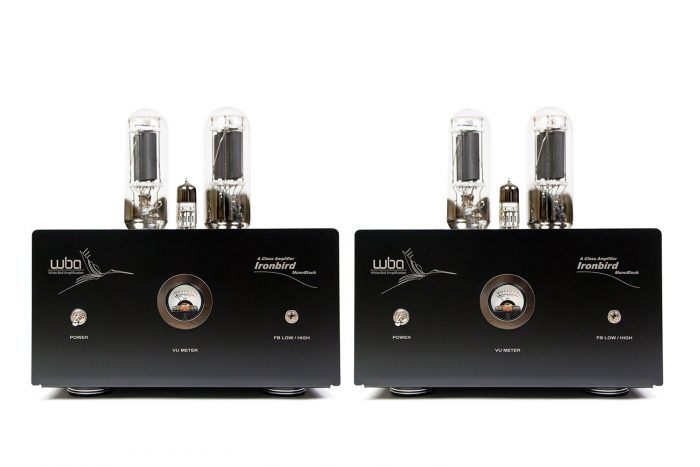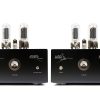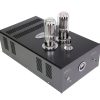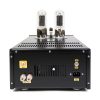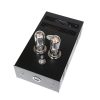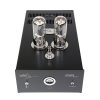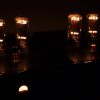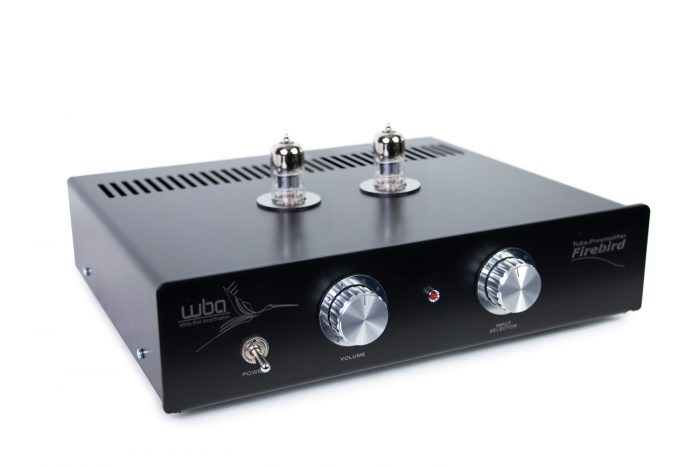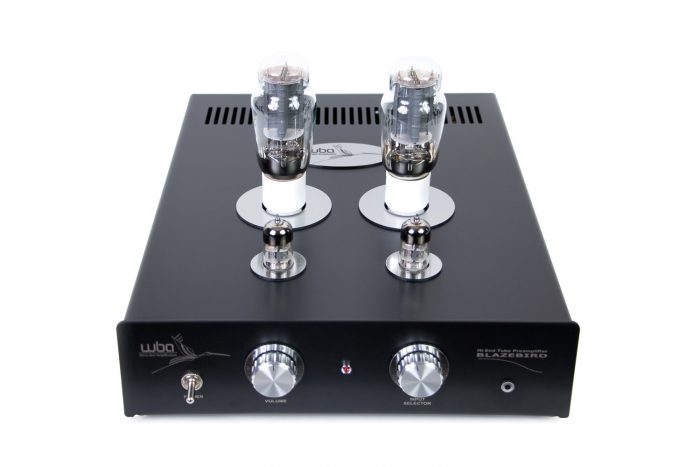Description
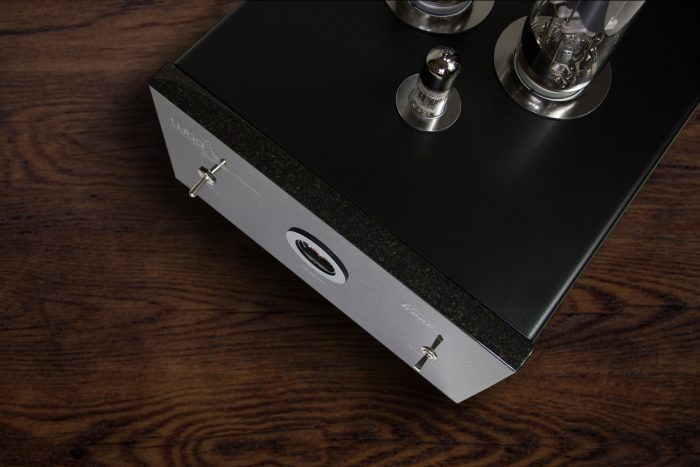 Ironbird Monoblock requires preamplifier signal. Dedicated devices are tube preamps: Firebird and Blazebird available in the offer of White Bird Amplification. The stereo preamplifier signal is given to the RCA input of each of the two monoblocks, which in turn are connected to one loudspeaker. Each of the monoblocks has the option of choosing a load impedance of 4Ω or 8Ω (for the impedance of 6Ω loudspeakers, the setting 8Ω is selected). The switch on the back panel serves for this. Ironbird Monoblock is not equipped with a volume control – the signal is fed directly from the input to its tube circuits. This allows you to completely eliminate the influence of regulators (potentiometer or attenuator) on the signal. VU meters are installed on the front panels to indicate the volume level of a given block. They have a backlight function, which also informs if device is turned on. Each of the mono blocks is equipped with an IEC type power network connector. At client’s request, it is possible to use components other than standard ones. This applies to the type of electron tubes and all signal sockets.
Ironbird Monoblock requires preamplifier signal. Dedicated devices are tube preamps: Firebird and Blazebird available in the offer of White Bird Amplification. The stereo preamplifier signal is given to the RCA input of each of the two monoblocks, which in turn are connected to one loudspeaker. Each of the monoblocks has the option of choosing a load impedance of 4Ω or 8Ω (for the impedance of 6Ω loudspeakers, the setting 8Ω is selected). The switch on the back panel serves for this. Ironbird Monoblock is not equipped with a volume control – the signal is fed directly from the input to its tube circuits. This allows you to completely eliminate the influence of regulators (potentiometer or attenuator) on the signal. VU meters are installed on the front panels to indicate the volume level of a given block. They have a backlight function, which also informs if device is turned on. Each of the mono blocks is equipped with an IEC type power network connector. At client’s request, it is possible to use components other than standard ones. This applies to the type of electron tubes and all signal sockets.
A single Ironbird Monoblock uses a pair of 211 Shuguang electron tubes which allows it to give continuous 40W power to the speakers without any distortion. 6H30Pi EHG works as driver tube. Each of the internal triodes is responsible for amplifying the voltage of the audio signal, which enables effective control of the power tubes. The purpose of the driver tubes is also to create the timbre of the sound and to give the amplifier dynamic character, which is felt especially in the lower registers of the band (bass speed). Type 211 or similar 845 power tubes are directly heated broadcasting triodes, which can also work well in the highest quality acoustic amplifiers. Their design requires the use of a specific power supply with voltage significantly exceeding 1000 V DC. In addition, the 211 heater needs to be provided with high-current DC power, because the power tubes in the Ironbird model in each block are connected in parallel. The advantage of this solution is the possibility of obtaining a relatively high power amplifier and the lack of a loudspeaker transformer having a greater number of windings in the secondary winding. A higher number of coils causes the parasitic transformer to create parasitic capacitances which adversely affects the transfer of high frequencies. The Ironbird model, using speaker transformers with fewer windings in the secondary winding, ensures exceptionally accurate transmission of the top band. In addition, a very large reserve of power in the 211 power supply (12 capacious high voltage electrolytic capacitors) enables dynamics comparable even with high power amplifiers in Push-Pull systems (AB class).
Ironbird offers a sound that is the quintessence of triode tubes. Warm, colorful and musical midrange and treble, with simultaneous depth and high dynamics of lower frequencies, make the reception of music very natural and pleasant to the ear. The saturation of the sound by even harmonics gives the impression of live music. Especially when it comes to vocals. Space in terms of the stage, depth of plans, as well as the stereophony itself are here at an uncompromising level. Contributing to this, among others complete power supply separation of the power tubes and the driver lamp. The last one has its own power supplies (anode and heater, both direct current), to which the voltages are supplied from independent windings of the supply transformer. Each of the blocks has two main power transformers. One is responsible for supplying anode voltages for 211 and 6H30Pi (here also incandescence voltage) and the other for providing power tubes. Separation of transformers increases the amplifier’s work culture and ensures better heat dissipation.
 Ironbird works in full class A, which ensures the highest fidelity of signal transmission and least distortion. The only disadvantage of this class is the low efficiency of the system, which causes relatively large heat losses and lower output power than in the case of Push-Pull amplifiers. This fact means that if users want to control loudspeakers with lower efficiency, users often choose AB class amplifiers. Although the Ironbird is a single-ended amplifier, the use of parallel 211 tubes in each of them (each 100W lamp) allowed 40W per channel for loudspeakers. Thanks to the power reserve, users of even more difficult to drive, less-efficient loudspeaker sets can successfully use this Class A amplifier in their systems.
Ironbird works in full class A, which ensures the highest fidelity of signal transmission and least distortion. The only disadvantage of this class is the low efficiency of the system, which causes relatively large heat losses and lower output power than in the case of Push-Pull amplifiers. This fact means that if users want to control loudspeakers with lower efficiency, users often choose AB class amplifiers. Although the Ironbird is a single-ended amplifier, the use of parallel 211 tubes in each of them (each 100W lamp) allowed 40W per channel for loudspeakers. Thanks to the power reserve, users of even more difficult to drive, less-efficient loudspeaker sets can successfully use this Class A amplifier in their systems.
As an additional option, each of the Ironbird amplifier monoblocks can be equipped with an additional rotary switch that allows you to adjust the depth of the feedback. Six further settings are available. In the first position feedback is the smallest which results in sound with the fastest fully controlled bass and a more technical midrange and treble. As the knob turns to the right, the feedback increases and the sound becomes warmer through the natural rounding of the center and the top of the band. In the full position of the switch to the right, the sound undergoes maximum warming, but the lower part of the band may be slightly “relaxed” which is a completely natural phenomenon. The compromise between the fast bass and the singing midrange and the bandwidth is obtained within the middle of the settings of the feedback controller (FB Low / High). The feedback control allows you to easily tune the amplifier to the characteristics of your speakers, signal source and acoustic properties of the listening room.

